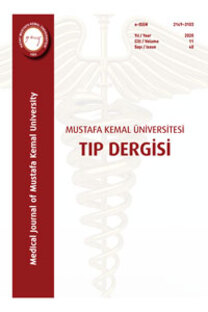Yoğun Bakımda Ateşin Nadir Bir Nedeni: Trafik Kazası Sonrası Yağ Embolisi Sendromu
Yağ embolisi sendromu (YES), solunumsal, hematolojik, nörolojik ve cilt belirtileri ile seyredebilen mikro dolaşımdaki yağ embolisinin sistemik belirtilerinden kaynaklanan klinik bir tablodur. Genellikle uzun kemik kırıklarından sonra ve 24-72 saat sonra ortaya çıkar. YES, insidansı, uzun kemik fraktürü sonrası % 0,5–3,5, pelvik fraktür veya çoklu uzun kemik fraktürü sonrası % 5–10 arasında değişmekte olan nadir bir klinik tablodur. Hastalarda ateş, ciddi solunum sıkıntısı, bilinç değişikliği, yaygın peteşi ve döküntülere ilaveten multiorgan yetmezliği görülebilir. Tanı genellikle klinik bulgulara dayansa da biyokimyasal değişiklikler yararlı olabilir. Sunulan olgu pat pat kazası sonrası ateş etyolojisi araştırılırken saptanan yağ embolisi sendromu olgusudur.
Anahtar Kelimeler:
Yağ embolisi sendromu, uzun kemik kırıkları, döküntü, ateş
A Rare Cause of Fever in Intensive Care Unit: Fat Embolism Syndrome After Traffic Accident
Fat embolism syndrome (FES) is a clinical manifestation of systemic symptoms of microcirculating fat embolism that may present with respiratory, hematological, neurological and skin symptoms. It usually occurs after long bone fractures and after 24-72 hours. FES is a rare clinical condition with an incidence of 0.5% and 3.5% after long bone fracture, 5-10% after pelvic fracture or multiple long bone fractures. Patients may experience fever, severe respiratory distress, change in consciousness, generalized petechiae, and multiorgan insufficiency. Biochemical changes may be useful in diagnosis, but the diagnosis is usually based on clinical findings. The case presented here is a case of fat embolism syndrome, which was detected in the etiology of fever after pat pat accident.
Keywords:
fat embolism syndrome, long bone fracture, rash, fever,
___
- Kwiatt ME, Seamon MJ. Fat embolism syndrome. Int J Crit Illn Inj Sci. 2013;3(1):64–8.
- Gauss H. The pathology of fat embolism. Arch Surg. 1924;9:592–605.
- Nachtwey FJ. Fat embolism syndrome. In: Bordow RA, Moser KM, editors. Manuel of Clinical Problems in Pulmonary Medicine, 4th ed. Boston: Little Brown Company; 1996.p. 301-4.
- Öngüç Aycan İ, Turgut H, Güzel A, Doğan E, Ölmez. Kavak G. Çoklu travma hastasında gelişen yağ embolisi sendromu. Firat Med J. 2014; 19(3): 156-8.
- Ross RM, Johnson GW. Fat embolism after liposuctions. Ches.t 1998; 93: 1294-5.
- Johnson MJ, Lucas GL. Review, Fat embolism syndrome. Orthopedics. 1996; 19(1):41-8.
- George J, George R, Dixit R, Gupta R C, Gupta N. “Fat embolism syndrome.” Lung India: official organ of Indian Chest Society. 2013;30(1): 47-53.
- Weinhouse G L. Fat embolism syndrome. [Internet]. [cited 2019 Sep 10]. Available from:https://www.uptodate.com/contents/fat-embolism-syndrome
- Bulauitan SC. Fat Embolism. [Internet]. [cited 2019 Sep 10]. Available from:https://emedicine.medscape.com/article/460524-overview#a7
- Capan LM, Miller SM, Patel KP. Fat embolism. Anesthesiol Clin North Am. 1993;11:25–54.
- Hekimoğlu -Şahin S, Memiş D, Çolak A. Propofol-Lidokain Karışımı ile Anestezi İndüksiyonunda Yağ Embolisi Gelişimi: Olgu Sunumu. Balk Med J. 2008;25(1):52-5.
- Bracco D, Favre JB, Joris R, Ravussin A. Fatal fat embolism syndrome: a case report. J Neurosurg Anesthsiol. 2000; 12: 221- 4.
- Fulde GW, Harrison P. Fat embolism- a review. Arch Emerg Med. 1991;8:233-9.
- Fabian TC, Hoots AV, Stanford DS, Patterson CR, Mangiante EC. Fat embolism syndrome: prospective evaluation in 92 fracture patients. Crit Care Med. 1990 Jan. 18(1):42-6.
- Broe PJ, Toung TJ, Margolis S, Permutt S, Cameron JL. Pulmonary injury caused by free fatty acid: evaluation of steroid and albumin therapy. Surgery. 1981. 89(5):582-7.
- White TO, Jenkins PJ, Smith RD, Cartlidge CW, Robinson CM. The epidemiology of post traumatic adult respiratory distress syndrome. J Bone Joint Surg Am. 2004;86:2366–76.
- Chhabra B, Kiran S, Senthilnathan TA, Gupta R. Fat embolism syndrome. Ind J Orthop. 2001;35:10–5.
- ISSN: 2149-3103
- Yayın Aralığı: Yılda 3 Sayı
- Başlangıç: 2010
- Yayıncı: Hatay Mustafa Kemal Üniversitesi Tıp Fakültesi Dekanlığı
Sayıdaki Diğer Makaleler
Aerobik Egzersizin Obez Erkek Çocuklarda Tiroid Hormon Düzeylerine Etkisi
Nuray SATILMIŞ, Leyla CİMEN, İhsan ÇETİN, Yahya POLAT, Behzat ÇİMEN
İntravajinal Mizoprostolün Gebelik Sonlandırılmasında Etkinliğinin Değerlendirilmesi
Cem YENER, Sinan ATEŞ, Cenk SAYIN, Süheyla GÖRMEZ, Füsun VAROL
Yoğun Bakımda Ateşin Nadir Bir Nedeni: Trafik Kazası Sonrası Yağ Embolisi Sendromu
Berke ARAS, Emel YILDIZ, Mehmet Ali GEDİK, Alaaddin Oktar ÜZÜMCÜGİL, Süleyman Kaan ÖNER
Tonsillektomi spesmenlerinin Histopatolojik Retrospektif Analizi
Doğum ve Doğum Sonu Dönemde Hasta Güvenliği ve Ebelerin Sorumlulukları
